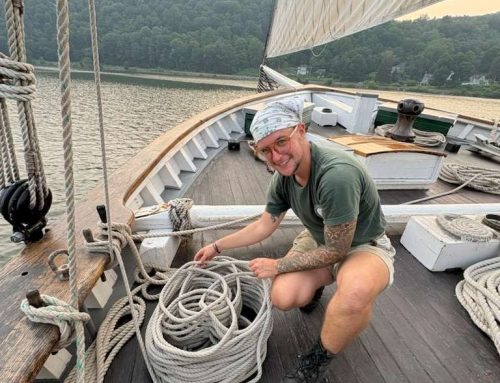Newly established Federal Maximum Contaminant Levels (MCL) of six per- and poly-fluoroalkyl substances (PFAS) in drinking water will reduce exposure in many Hudson Valley communities and should influence the cleanup of contamination affecting Newburgh and New Windsor drinking water sources
FOR IMMEDIATE RELEASE: April 10, 2024
NEWBURGH, NY – Community members of the Stewart Air National Guard Restoration Advisory Board applaud the Environmental Protection Agency’s (EPA) historic announcement today, setting its first-ever national enforceable drinking water standards focused on six (6) per- and polyfluoroalkyl substances (PFAS). These are the first national regulations to include the toxic chemicals that had contaminated the drinking water of the City of Newburgh for decades due to the military’s use of PFAS-containing firefighting foams at the Stewart Air National Guard Base.
Known to be linked to serious health problems that include thyroid disease, liver damage, cancer, and harm to reproductive & immune systems, PFAS are a class of over 14,000 highly toxic chemicals often referred to as “forever chemicals” due to their persistence in humans and the environment. PFAS are used in a wide range of industrial processes and are found in a dizzying range of consumer products and packaging. PFAS predominately enter waterways and drinking water sources through domestic and industrial wastewater discharges, and the use of certain firefighting foams by the military and airports. Aqueous film-forming foam (AFFF) used at the Stewart Air National Guard Base is the main source of PFAS contamination affecting drinking water sources in the City of Newburgh and the Town of New Windsor.
Until Newburgh stopped using Washington Lake as its source of drinking water in 2016, tens of thousands of residents and workers in the City of Newburgh had unknowingly been exposed to harmful PFAS chemicals for decades. The City of Newburgh has since transitioned to temporary alternative sources of water: New York City’s upstate reservoirs, via the Catskill Aqueduct, and Newburgh’s backup reservoir, Brown’s Pond. PFAS have been detected in many other public and private water supplies throughout the region. Establishing the EPA’s groundbreaking National Primary Drinking Water Standards will reduce harm to public health and take significant steps toward protecting the health and well-being of communities in the Hudson Valley and across the United States.
Under federal regulations that guide the remediation of PFAS contamination at Stewart Air National Guard Base, the new standards will influence cleanup goals. Restoration Advisory Board members have been calling to “Speed Up the Cleanup” at Stewart, urging the Base to take actions to reduce the flow of contamination off the base while it completes the years-long process of designing a long-term cleanup solution.
About the Stewart Air National Guard Restoration Advisory Board:
The Stewart Air National Guard Base Restoration Advisory Board acts as a forum to exchange information and discuss the environmental remediation of the Base, and for the community to provide input on the cleanup process. The Board is made up of representatives from the community, local governments, and non-governmental organizations, in addition to the Air National Guard and agencies with regulatory roles in overseeing the cleanup. Members include representatives of non-governmental organizations, including Newburgh Clean Water Project, Riverkeeper, Hudson River Sloop Clearwater, Quassaick Creek Watershed Alliance, the Newburgh Conservation Advisory Council, the NAACP’s Newburgh-Highland Branch, Moodna Creek Watershed Intermunicipal Council, and Toxic-Free Future. Restoration Advisory Board meetings are open to the public. The next meeting is Wednesday, April 24, at 5:30 p.m. at the Newburgh Armory Unity Center, 321 S. William Street, Newburgh, NY 12550.
Restoration Advisory Board Community Member Statements:
Jennifer Rawlison of Newburgh Clean Water Project states, “As a lifelong City of Newburgh resident and mother, today not only recognizes the EPA’s continued commitment to protecting the public from harmful PFAS exposure but the hard work that so many impacted individuals have hoped to accomplish. May this action be just one of many steps to protecting families across the nation and environmental justice communities such as ours who carry an even heavier burden. This decision ensures a safer, healthier future for all.”
“Today marks a pivotal moment in our collective journey towards safeguarding the health of our communities and the integrity of our environment. The EPA’s establishment of national drinking water standards for PFAS is a testament to the power of informed advocacy, community engagement, and the relentless pursuit of environmental justice. This decision not only reflects a significant advancement in public health protection but also reinforces our commitment at the Stewart Air National Guard Restoration Advisory Board to advocate for comprehensive and expedient cleanup efforts,” said Edward Lawson, Jr., JD, MBA, Co-chair Stewart Air National Guard Restoration Advisory Board & Founder and President of Family and Community Engagement Services, Inc. (FACES). “As we celebrate this milestone, let us also recommit ourselves to the ongoing work of ensuring that our water is free of contaminants and that future generations inherit a cleaner, healthier world. Together, we are turning the tide against ‘forever chemicals’ and paving the way for a future where the well-being of our families and communities is not compromised by the negligence of the past.”
“EPA’s new PFAS regulations underscore the need for the Stewart Air National Guard to move much more aggressively to prevent PFAS contamination from traveling off-site, contaminating waterbodies downstream whenever it rains,” said Mike Schade, director of Mind the Store at Toxic-Free Future, based out of its national office in Newburgh. “April showers shouldn’t bring forever chemicals. The Air National Guard has to do a much better job to turn off the tap on PFAS pollution in Newburgh, a city that has suffered from PFAS contamination for far too long.”
“Today’s announcement establishing national enforceable drinking water standards for a subset of PFAS chemicals is critical for protecting communities from exposure to toxic chemicals nationwide, and strengthens the obligation of the National Guard to remediate PFAS contamination at and running off of the Stewart Air National Guard Base. For decades, this contamination poisoned Newburgh’s primary drinking water source, and it continues to affect the area’s waterways,” said Jen Benson, Environmental Action Director, Hudson River Sloop Clearwater.
“Because these new federal drinking water standards are more protective than New York’s current standards, the EPA’s regulations will result in reduced exposure to harmful PFAS in drinking water, and influence the cleanup goals at sites like Stewart Air National Guard Base, said Dan Shapley, Riverkeeper’s Senior Director of Advocacy, Policy and Planning. “The bad news is that many drinking water sources in the Hudson Valley have detectable levels of PFAS. The good news is that these new regulations will protect many of our neighbors from further exposure to these chemicals.”
Contact:
Jennifer Rawlison, Newburgh Clean Water Project jen@newburghcleanwaterproject.org
Edward Lawson, co-chair of the Restoration Advisory Board, and president of FACES, Inc., 845-290-2763
Jen Benson, Hudson River Sloop Clearwater, Jen@clearwater.org
Lewis Kendall, Riverkeeper, 914-478-4501 ext. 238 or LKendall@riverkeeper.org
Mike Schade, Toxic-Free Future, mschade@toxicfreefuture.org





